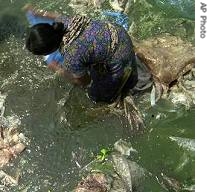2007年VOA标准英语-WWF Says World's Mightiest Rivers Are at Risk(在线收听)
New Delhi
20 March 2007
The World Wide Fund for Nature says some of the world's mightiest rivers are dying, threatening the livelihoods of millions of people. The conservation group has identified 10 top rivers, and called for governments to step up efforts to preserve them. Anjana Pasricha reports from New Delhi, where the WWF issued its study.

Bangladeshi woman clean dirty polythene shopping bags in polluted waters of Buriganga river in Dhaka, 19 Mar 2007
They were once mighty freshwater bodies on whose banks human civilizations were born. But now, many of the world's great rivers are threatened by over-extraction of water, climate change, construction of large dams, and pollution.
The World Wide Fund for Nature says rivers at risk are found on almost every continent - the Yangtze, Mekong, Salween, Ganges and Indus in Asia, the Danube in Europe, the Plata in South America, the Rio Grande in North America, the Nile in Africa, and the Murray-Darling in Australia.
The conservation group says most rivers no longer run freely from source to sea. It says dams are altering their natural flow, industrial effluents have polluted their waters, and 20 percent of the world's 10,000 freshwater species have become extinct.
The threats vary. For example, the Salween in South East Asia is under pressure due to damming, while the Danube is threatened by the dredging and straightening of banks to ease shipping. The Rio Grande in the United States and the Ganges in South Asia are falling victim to over-extraction of water for irrigation and domestic consumption. The Indus faces a threat from climate change because of its high dependency on glacier water.
The WWF's coordinator for freshwater policy, Vidya Moni, outlined some of the problems in New Delhi.
"Large infrastructure was a big threat to the river Nile, there was a big threat to river Danube in terms of pollution which was extensively caused because of industrialization, river Yangtze in China is over-polluted, with coal mining happening on the fringes," she said.
The report says communities living on riverbanks are the worst affected, threatened with loss of their water-based livelihoods, such as fishing and agriculture.
Gurdev Singh is from Punjab state in northern India. He has witnessed the severe degradation in recent decades of the Ganges, which flows by his village.
Singh says the water was once so clear, it was possible to see fish swimming in the river. Now, industrial effluents have polluted the river severely. As a result, crop yields have been reduced, and animals drinking the water turn sick.
The secretary-general of WWF-India, Ravi Singh, has called for governments to radically step up efforts to preserve freshwater sources, and treat river conservation as part of national security and economic policy.
"The risks that we see on these issues are going to multiply unless we change the way we are set today. And these risks are such that [they] are going to affect communities, they are going to effect biodiversity, wild life, climate," said Singh.
WWF says 40 percent of the world's population now lives in river basins that are under stress.